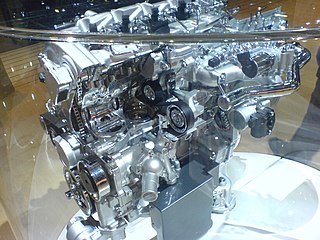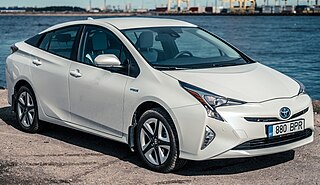Related Research Articles

The Toyota AZ engine family is a straight-4 piston engine series. The AZ series uses an aluminium engine block with cast iron cylinder liners and aluminium DOHC cylinder head. The engine series features many advanced technologies including slant-squish combustion chambers, offset cylinder and crank centers, and the VVT-i continuously variable intake valve timing system. The aluminium engine measures 626 mm (24.6 in) long, 608 mm (23.9 in) wide, and 681 mm (26.8
Toyota Motor Corporation's A family is a family of automatic FWD/RWD/4WD/AWD transmissions built by Aisin-Warner. They share much in common with Volvo's AW7* and Aisin-Warner's 03-71* transmissions, which are found in Suzukis, Mitsubishis, and other Asian vehicles.
Toyota Motor Corporation's U family is a family of automatic front-wheel drive/rear-wheel drive/four-wheel drive transmissions found in later vehicle models.
FAW Toyota Motor Co., Ltd. (FTMC), previously named Tianjin FAW Toyota Motor Co., Ltd. (TFTM), is an automobile manufacturing company based in Xiqing District, Tianjin, China. It is a manufacturing and supervising affiliate of the joint venture between Toyota Motor Company and First Automobile Works, and commonly known as FAW Toyota.
Shigeyuki Hori is the principal designer of Toyota's acclaimed Hybrid Synergy Drive hybrid motor system which is in use by several vehicles including the Prius and Lexus RX Hybrid. An executive chief engineer in Toyota Motor Corporation, Dr. Hori served as chief engineer for more vehicles simultaneously than any other person in the company's history, by taking charge of the Prius, Celica, MR2, Caldina, Opa, Avensis, and Scion tC development efforts in the early to mid-2000s.

The Toyota Auris is a compact car derived from the Corolla, manufactured and sold by Toyota. Introduced in 2006, the first generation three/five-door hatchback shared the platform with the E150 series Corolla, while the second generation five-door hatchback and station wagon called "Touring Sports" uses the E180 platform. The "Auris" name is based on the Latin word for "gold", "aurum".

Calty Design Research Incorporated is a Toyota design studio established in 1973. They have two facilities: one in Newport Beach, California for concept designs, and another in Ann Arbor, Michigan for production designs. Calty provides both interior and exterior styling proposals for future Toyota vehicles and advanced design, production color and wheel design concepts for Toyota's product development operations.

The ZR engine is a family of straight-four 16-valve all-aluminum and water cooled gasoline engines with a die-cast aluminum block and variable valve timing developed by Toyota Motor Corporation, produced from 2007. Engines displace from 1.6 to 2.0 liters. Most engines in this family are equipped with Toyota's dual VVT-i technology that optimizes both intake and exhaust valve timing. This engine family is also the first to use Toyota's Valvematic system, first appearing on the Noah and Voxy in 2007 and then the European Avensis in 2009.

The Toyota AD engine family is a series of 16 valve DOHC inline-4 turbo diesel engines with electronic common rail direct injection using an aluminium cylinder head and an aluminium cylinder block with cast iron liners derived from the petrol Toyota AZ engine. The AD engine is offered in 2.0 and 2.2 liter versions. These engines are produced mainly for Europe, but few are exported to other areas such as India or New Zealand.

The Toyota Corolla (E140/E150) is the tenth generation of cars sold by Toyota under the Corolla nameplate. The Toyota Auris replaced the Corolla hatchback in Japan and Europe, but was still badged "Corolla" in Australia and New Zealand.

The Toyota Mark X ZiO is a mid-size MPV manufactured by Toyota from 2007 to 2013. Replacing the Mark II Blit station wagon, it was sold exclusively in Japan and was exclusive to Toyopet Store dealerships, sold alongside the Mark X sedan from September 2007.

The Lexus HS is a dedicated hybrid vehicle introduced by Lexus as a new compact executive car sedan in 2009. Built on the Toyota New MC platform, it is classified as a compact under Japanese regulations concerning vehicle exterior dimensions and engine displacement. Unveiled at the North American International Auto Show in January 2009, the HS 250h went on sale in July 2009 in Japan, followed by the United States in August 2009 as a 2010 model. The HS 250h represented the first dedicated hybrid vehicle in the Lexus lineup, as well as the first offered with an inline-four gasoline engine. Bioplastic materials are used for the vehicle interior. With a total length of 4,700 mm (190 in), the Lexus HS is slightly larger than the Lexus IS, but still smaller than the mid-size Lexus ES.
Toyota Motor Corporation's E family is a family of 5/6-speed manual transmissions for FWD/RWD/4WD vehicles.

The Toyota K CVT transmission is a series of continuously variable transmissions (CVT) found in many Toyota and Lexus automobiles. The transmissions are manufactured for the company by Aisin, an automotive parts manufacturer that is part of the Toyota Group of companies. A CVT is a type of automatic transmission that can change seamlessly through a continuous range of gear ratios. This contrasts with other transmissions that provide a limited number of gear ratios in fixed steps. The K series uses two pulleys connected by a belt.
The Toyota K platform, informally known as the Toyota Camry platform, is a front-wheel-drive automobile platform that has underpinned various Toyota and Lexus models from the mid-size category upwards since September 1999, starting with the Avalon (XX20). Besides the Camry, the K platform was used on minivans, crossovers and luxury sedans. This platform was larger than the front-wheel-drive MC and New MC platforms, but less upscale than the N and New N platforms designed for rear-wheel drive luxury applications. Starting with the XV70 Toyota Camry (2017), the new K platform (TNGA-K) is part of the Toyota New Global Architecture (TNGA).

The Toyota New Global Architecture are modular automobile platforms that underpin various Toyota and Lexus models starting with the fourth-generation Prius in late 2015. TNGA platforms accommodate different vehicle sizes and also front-, rear- and all-wheel drive configurations.

The Dynamic Force engines are a family of internal combustion engines developed by Toyota under the brand's Toyota New Global Architecture (TNGA) strategy. The engines can be fueled by petrol (gasoline) or ethanol and can be combined with electric motors in a hybrid drivetrain. The engines were developed alongside the TNGA family of vehicle platforms, as part of a company-wide effort to simplify the vehicles being produced by Toyota.

Toyota vehicles in Japan are distributed to numerous dealership chains throughout the country. Up to May 2020, each dealership chain had a different product offering, with some models restricted to one chain to maintain exclusivity. Since May 2020, every Toyota model in Japan was available in all dealership chains. Current dealership chains include Toyota Store, Toyopet Store, Toyota Corolla Store and Netz Store.

Toyota Motor Korea Co., Ltd. is the South Korean subsidiary of Japan-based conglomerate Toyota, which specializes in the sales and distribution of Toyota and Lexus automobiles in South Korea.
References
- 1 2 力, 田野倉 (27 December 2005). "Toyota RAV4". Nikkei Technology Online (in Japanese). Retrieved 18 June 2014.
RAV4もトヨタのCDセグメント用「新MC(ミディアム・コンパクト)プラットフォーム」の採用第一号車となっている。
- 1 2 3 4 5 6 7 8 9 10 11 12 13 14 15 16 17 Akita, Masahiro; Shiohara, Kunihiko (11 June 2012). "Observations on TNGA: How will Toyota's plans to make better cars affect suppliers". Credit Suisse. pp. 2, 4. Archived from the original (PDF) on 17 June 2014.
- ↑ Akita, Masahiro (11 March 2013). "Opportunities and risks related to parts sourcing for next-gen Prius". Credit Suisse. pp. 1–3. Archived from the original (PDF) on 17 July 2014.
- ↑ "トヨタの「オーリス」と「エスティマ」が兄弟車!? プラットフォームの共通化について考える" [Toyota's "Auris" and "Estima" are brother cars!? Considering common platform]. webCG (in Japanese). Retrieved 2023-04-18.